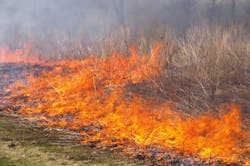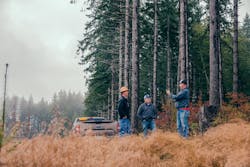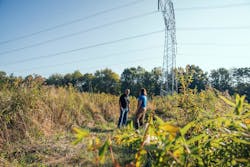Utility infrastructure may not cause every wildfire, but every wildfire has the propensity to damage utility infrastructure. More than 7.5 million acres of U.S. land were burned by 68,988 wildfires in 2022 (National Interagency Fire Center), threatening the electricity grid, wildlife habitat and surrounding communities along the way.
With extended drought, tree mortality and the establishment of invasive plant communities contributing to this increase in wildfires over the past few years, utility vegetation managers should follow these four guidelines to mitigate wildfire risks and protect utility infrastructure. Doing so also can help utilities reduce the number of wildfires ignited by electrical power, strengthen the reliability of electrical service and enhance public safety.
1. Keep Vegetation Clear of Escape Routes
Controlling vegetation under power lines along roadsides can eliminate infrastructure threats that also can block escape routes or site accessibility for first responders. For optimal results, supplement mechanical and biological control methods with targeted applications of selective herbicides. Together, these Integrated Vegetation Management (IVM) strategies can eliminate at-risk limbs and prevent the development of ladder fuels in and around utility rights-of-way.
Applying tree growth regulators also can impede the development of fast-developing trees that pose a threat to grow into energized conductors. On the ground, any woody plants that are manually removed can increase fuel loads, which is why vegetation managers and their industry partners are encouraged to use chippers to broadcast chips at low levels after treatment.
2. Establish Fuel Breaks
Utility rights-of-way are expansive landscapes that can serve as strategic locations for fuel break establishment. Utility vegetation managers can use a variety of IVM-based strategies to control tall incompatible plants and flammable low-growing vegetation in these areas, but few are as effective in the long term as targeted applications of selective herbicides.
“Selective herbicides are a great way for vegetation management teams to prevent the regrowth of incompatible stems,” said Beau Miller, Vegetation Management Specialist, Corteva Agriscience. “This reduces long-term maintenance costs and enhances fuel break performance.”
Fuel breaks aren’t guaranteed to prevent wildfires, but they do provide safer areas for firefighters to prevent flames from spreading. These areas can buy critical time that saves lives and valuable resources, which is why utility vegetation managers should partner with other agencies and land entities conducting their own fuel-reduction projects.
3. Establish and Build Positive Working Relationships
Fuel breaks have the ability to connect land owned by different entities and communities. While city and state agencies can support fuel break establishment along roads to improve site accessibility during wildfires and related emergencies, timber companies as well as state and national parks can remove dead and hazardous trees to reduce the amount of flammable vegetation near the edge of right-of-way corridors or common areas, including parks and campgrounds.
Utility companies and their vegetation management partners can support these like-minded entities by assisting with tree removal in logging areas where line-clearance certified workers are required. By collaborating with these industry partners, vegetation managers can enhance wildfire mitigation and align on messaging that educates landowners on the benefits their applied strategies provide to surrounding communities.
4. Spread the Word
Landowners are often more comfortable with certain IVM-based strategies than others. For instance, mechanized mowing is familiar, and the process is easy to understand. However, landowners can be skeptical of chemical control methods. That’s why it’s important for all contributing parties to understand product labels and the benefits chemical control methods can provide to vegetation management and wildfire mitigation programs.
Retaining this knowledge is the key to effective landowner communications. From fuel break establishment and maintenance cost reductions to biodiversity benefits and pollinator habitat improvements, IVM programs featuring selective herbicide applications can yield multiple benefits worth sharing with the general public.
“Helping landowners, land entities and the public understand the purpose of your work and the benefits it provides is a simple way to increase compliance and reduce complaints,” Miller said. “At Corteva, we actually developed the Notify Your Neighbor digital guide to improve landowner communications regarding vegetation management along utility rights-of-way.”
Notify Your Neighbor is filled with techniques and key messages that can enhance notification programs for energy companies and contract employees alike. To explore these resources and enhance notification programs for utility companies, licensed applicators and/or industry partners, access the Notify Your Neighbor platform here.
For more information about utility strategies supporting wildfire mitigation programs, visit this online resource developed by Corteva Agriscience.
™ ® Trademarks of Corteva Agriscience and its affiliated companies.
Sponsored By:



